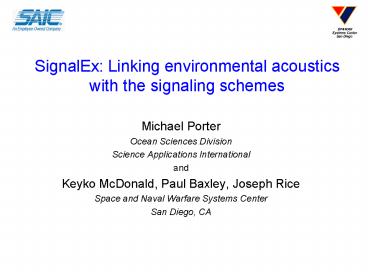SignalEx: Linking environmental acoustics with the signaling schemes - PowerPoint PPT Presentation
Title:
SignalEx: Linking environmental acoustics with the signaling schemes
Description:
SignalEx-D (Buzzard's Bay) August 10-11, 2000. Ray/beam trace and incoherent TL. CTD Record ... SX-D (Buzzard's Bay) impulse response. Drift 1: 0-3.5 km. Drift ... – PowerPoint PPT presentation
Number of Views:22
Avg rating:3.0/5.0
Title: SignalEx: Linking environmental acoustics with the signaling schemes
1
SignalEx Linking environmental acoustics with
the signaling schemes
- Michael Porter
- Ocean Sciences Division
- Science Applications International
- and
- Keyko McDonald, Paul Baxley, Joseph Rice
- Space and Naval Warfare Systems Center
- San Diego, CA
2
Outline
- Motivation Case study Front engineering test
- SignalEx tests
- Telesonar testbeds
- Sites b, c, d
- Measured channel impulse response
- Predicted channel impulse response
- Performance of a DPSK/DSSS system
3
The National Oceanographic Partnership Program
(NOPP) FRONT system is being installed by a
consortium led by U. Conn
- Cellular modems relay data to shore from the
Montauk Point and Block Island USCG buoys - ADCP sensor nodes with trawl-resistant bottom
frame design - Diver-free recovery acoustic release holds ball
floats, line packed in canister. - Acoustic modem (azimuthal omnidirectional 409
transducer) at apex all other components below
its lower plane. - Smooth outer surface to limit snaring of fishing
gear.
9-km spacing
4
Upward refraction in FRONT-1 caused strong
dependence on the sea-surface boundary
Range (m)
Year-day
5
Summary
- The environment can have a big effect on modem
performance - These effects are not well understood
- SignalEx program
- study a variety of modems in diverse environments
- learn which work and when
- optimize modem parameters
- develop and validate a channel model to provide a
predictive capability for modem performance - Result Smart Modem selects best operating
mode for the channel
6
Modem schemes tested in SignalEx
type Method Analysis group
a Multi-frequency shift keyed (MFSK) SAIC/SPAWARSSC
b Frequency-Hopped FSK (FH-MFSK) Benthos
x Differential phase-shift keyed (DPSK) Northeastern Univ. SAIC/SPAWARSSC
d N-QAM (BPSK, QPSK, 16-QAM) Northeastern Univ., Delphi, NUWC, Benthos
e Pulse-Position Modulation (PPM) SAIC/SPAWARSSC
g Orthogonal Frequency Division Multiplexing (OFDM) Polytechnic Univ.
h Multi-Carrier Code Division Multiple Access (MC-CDMA) Polytechnic Univ.
7
Mk-1
Telesonar testbeds
Mk-2, 2000-01
Mk-1, 1998-99
Mk-1 Sublink98
8
SignalEx waveform
LFM chirps (8-11 kHz)
Type-a MFSK waveforms
7-tone comb
LFM chirps (8-16 kHz)
Type-x DPSK waveforms
9
SignalEx spectrogram
LFM chirps (8-11 kHz)
Type-a MFSK waveforms
7-tone comb
LFM chirps (8-16 kHz)
Type-x DPSK waveforms
10
SignalEx 2000 experiment locations
SX-D Buzzards Bay (in SeaWeb00) August 10-11,
2000
SX-C San Diego (in SubLink00) May 23-25, 2000
SX-B New England Shelf (in ForeFront) April
17-20, 2000
11
SignalEx-B in ForeFRONT (New England Shelf) April
17-20, 2000
12
SignalEx-C in Sublink (Point Loma)May 23-25, 2000
13
SignalEx-D (Buzzards Bay)August 10-11, 2000
14
Ray/beam trace and incoherent TL
15
CTD Record
16
Predicted Impulse Response
17
SX-B (New England Shelf)impulse response
18
SX-C (San Diego)Eigenrays and impulse response
19
SX-D (Buzzards Bay) impulse response
Drift 1 0-3.5 km
Drift 2 2.2-4.2 km
Drift 3 1.4-3.8 km
20
Type-x (DPSK) bit error rates
Range 7 km
Range 5 km
21
MFSK BER
22
DSSS/DPSK (type-x)
- Transmitter
- ½ rate, contraint length 7 convolutional coder
- (interleaver)
- Gold sequence for spreading (4000 chips/sec)
- BPSK on I/Q channels (QPSK out) (12 kHz carrier)
- Shaping filter
- Receiver
- RAKE receiver, variable number of taps (or
sparse) - Delay-locked loop
- Viterbi decoder, 35 stage lookback
- (John Proakis/Ethem Sozer Delphi/NEU)
23
DSSS/DPSK (type-x) bit errors in SX-B400-bit
transmissions8 kHz bandwidth
24
DSSS/DPSK bit errors in SX-C64-bit
transmissions 3 kHz bandwidth
R3 km
R5 km
25
DSSS/DPSK bit errors in SX-D (Drift 1)500-bit
transmissions 8 kHz bandwidth
Channel errors
Convolutional coding
26
DSSS/DPSK bit errors in SX-D (Drift 3)500-bit
transmissions 8 kHz bandwidth
Channel errors
Convolutional coding
27
Summary
- Channel impulse response is well-predicted by
classical multipath picture - Type-x multi-access DPSK performs reliably at 100
bps in all cases tested to date (ranges from 0-7
km) - Further SignalEx analysis will provide
common-platform comparisons between many
signaling schemes
















![Acoustics and Microphones [Acoustic Guitars Part 2] PowerPoint PPT Presentation](https://s3.amazonaws.com/images.powershow.com/6974127.th0.jpg?_=20190218013)














